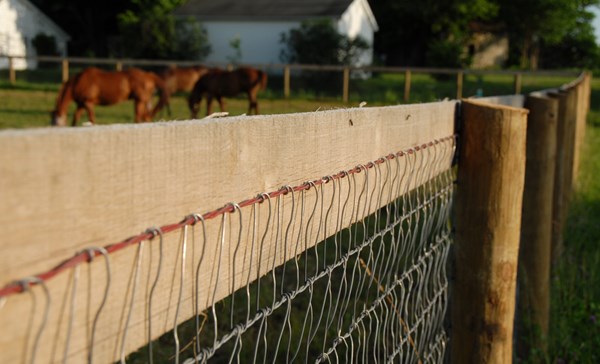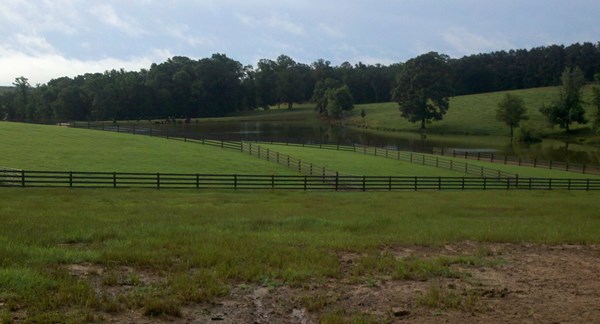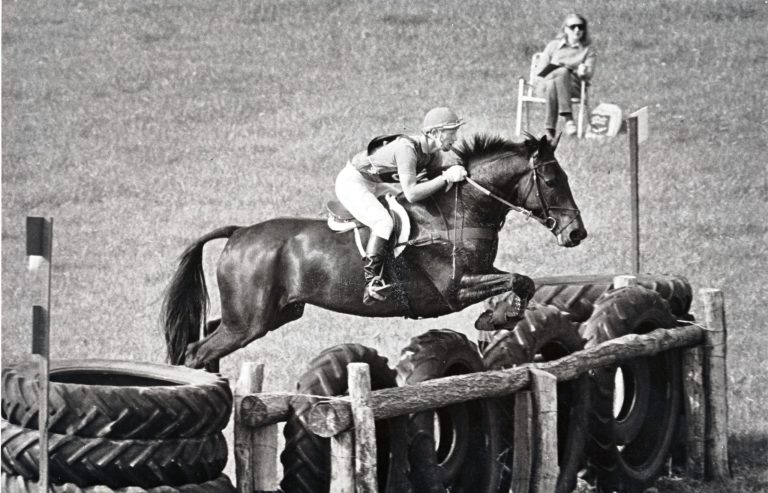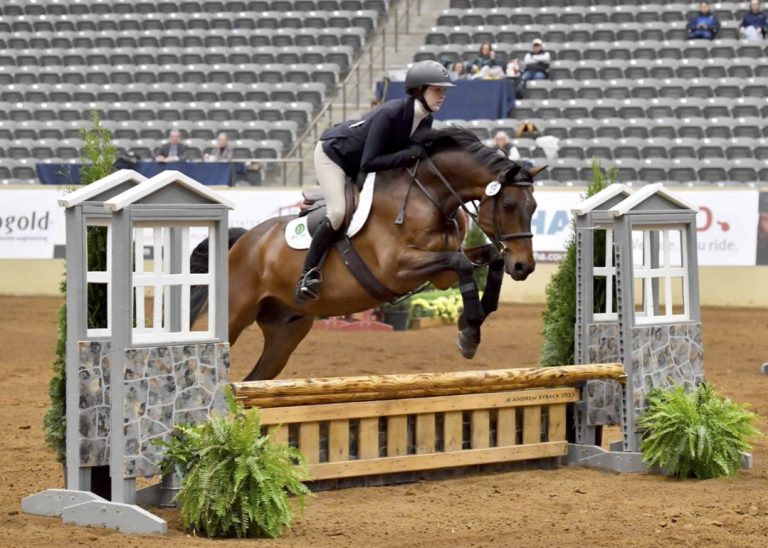Last month, we introduced you to a new system for prioritizing your fencing needs. This month, we’ll put that system to the test, showing you how different products matched the priorities of four unique fencing projects. These projects represent a wide range of budgets, acreages, herd compositions and installation/maintenance abilities. Some addressed hard lessons learned from past experiences with other types of fencing. All of our interviewees did their homework—and all are very happy with their choices.
 For all four fencing projects, the safety of the horses was the number-one priority. | Courtesy, Tonja and Jeff Millet
For all four fencing projects, the safety of the horses was the number-one priority. | Courtesy, Tonja and Jeff MilletLike most horse owners, our interviewees considered safety their number-one priority. They wanted a fence that would minimize the risk of injury to a horse crashing into it, pawing or kicking at it or getting trapped under it.
In each case, the owner either provided adequate high-quality grass to keep the horses content or supplemented with hay and grain. This minimized the incentive for horses to look outside the pasture for food.
The fencing projects are presented here in order of cost, with the most affordable first. Note: As we explained last month, prices vary widely depending on your region, pasture size and configuration, and installation labor (if you don’t install the fence yourself).
 The lowest strand on Danny’s four-strand ElectroBraid® electrified fence is about 18 inches above the ground, allowing Danny to easily mow the vegetation under the fence with his tractor. | Photo Courtesy, Danny Harmon
The lowest strand on Danny’s four-strand ElectroBraid® electrified fence is about 18 inches above the ground, allowing Danny to easily mow the vegetation under the fence with his tractor. | Photo Courtesy, Danny HarmonDIY on a Budget
Danny Harmon designed his seven paddocks on 20 acres in Norlina, North Carolina, eight years ago to keep his Quarter Horse stallion, broodmares and foals separate. He has since ended his breeding program and now owns two 22-year-old retired mares, seven youngsters, aged 6 and under, and two mini mules. He occasionally hosts ranch sortings (Western-style competitions similar to team penning) and allows some participants to put their horses in his paddocks.To prevent fighting, Danny separates his herd by sex and age. He also rotates the groups through the paddocks, giving eaten-down grass time to grow back. This, along with his low herd density (about 2.5 acres per horse), helps to maintain good-quality grass in spring, summer and fall. In the winter, he supplements with hay and grain, spacing it out well around the pasture to avoid competition among horses.
Top priorities
• Budget:Danny sought an extremely affordable product that would still be safer for horses than high-tensile wire. “I would never put that up,” he says. “I’ve seen horses get cut up in it.”
• Containment:“I wouldn’t have a pasture if I didn’t want to keep the horses in it!” says Danny, who also wanted to prevent horses from interacting over the fence with their neighbors in adjoining paddocks.
• Maintenance:A full-time farrier, Danny doesn’t have time to check and repair his fences frequently. He particularly wanted a product that would discourage horses from rubbing, leaning or chewing on the fence, and thus save time and money in fence repairs.
• Longevity:Danny’s goal was to invest his time and skills installing a fence that would last for decades.
Additional considerations
• Aesthetics:Both for himself and his occasional visitors, Danny wanted a clean, nice-looking fence.
• Wildlife: In the past, Danny has seen deer run through electric tape fencing, which stretched and broke. He wanted a fence that could stand up to that pressure, without injuring wildlife.
Fence choice:With these factors in mind, Danny chose to install four-strand ElectroBraid® electrified fence in 2006. Made of conductive copper wires braided into high-grade polyester fiber, this rope stretches on impact, then bounces back into place. “It’s a very safe, very user-friendly, easy-to-put-up fence,” says Danny, who was especially drawn to the 25-year warranty. Altogether, his project totaled between $1.70 and $2 per linear foot of fence.
Installation:Like many fence manufacturers, ElectroBraid provided a detailed installation guide, which Danny followed closely. “The grounding was the most important part,” he says. He also invested in one of the more powerful fence chargers, to be sure the entire property would be dependably electrified.
Because his 8-inch-diameter corner posts bear all of the pressure of the ropes, Danny could space his line posts 30 feet apart. For aesthetic purposes, he spent extra time concreting each line post by hand to make them perfectly vertical. “When you look down the fence line,” he says proudly, “you can only see the post in front of you. I have a very straight fence!”
To complete the project he says, “the posts were the hardest part and the insulators [which connect the strands to the fence] were the most time-consuming part. The rope, itself, was very easy to work with.”
Gates: Danny chose 12-foot galvanized steel panel gates for his paddocks. Looking back, he wishes that he’d gone with larger gates, explaining, “Getting the 10-foot mower in and out is a little tight.”
Fence performance: In eight years, the fence has remained “very structurally sound and low maintenance,” says Danny. The electricity has been reliable, except when storms knocked out his power. The fence charger has been struck by lightning several times. “I got it fixed once or twice, then had to replace it.” (The warranty did not cover lightning damage.)
Storms have also knocked heavy limbs onto the fence, which stretched without breaking. “I just cut the limbs off and the fence pops back up,” Danny says.
Deer ran through the fence once, pulling down the rope and breaking an insulator, which was easy to replace.
Although the horses learned to respect the electricity quickly, one horse did catch a foot in the fence and pulled a strand free from a post, breaking the insulators. He extricated himself without suffering more than some rubbed-off hair. The fence repair was simple, says Danny. “It just took two screws and a new insulator.”
The strands are spaced one foot apart, with the lowest about 18 inches above the ground and the highest about 4-foot-6. This has contained the largest and smallest members of Danny’s herd effectively.
An added bonus of the 18-inch bottom strand and the widely spaced fence posts is that Danny can easily mow the vegetation under the fence with his tractor.
 Made of galvanized wire with a zinc coating, Red Brand’s Keepsafe® V-mesh has a weave pattern that stretches on impact, then bounces back in place. | Courtesy, Mark Otto
Made of galvanized wire with a zinc coating, Red Brand’s Keepsafe® V-mesh has a weave pattern that stretches on impact, then bounces back in place. | Courtesy, Mark OttoHaven for Retirees
Old Friends (oldfriendsequine.org) tries to create what its founder, Michael Blowen, calls “a little utopia” for retired racehorses. Now caring for 131 horses in four locations in Kentucky and New York, the nonprofit is supported by a few extremely generous donors, the Thoroughbred Aftercare Alliance “and a lot of our fans.” Its aging residents range from Breeders Cup champion Gulch and Whitney Handicap winner Commentator to, as the website describes, “horses who have never earned much more than our love and respect.”
“Most of the new arrivals haven’t been on pasture since they were yearlings,” says Michael. They’re turned out alone in roundpens first, until they’ve calmed down. Stallions are then moved to individual 2-acre paddocks. Mares and geldings are tested in a paddock with a steady, smart companion of the same sex before being introduced to a same-sex group pasture.
The natural environment has an almost magical effect on the ex-racehorses. “Once they realize they’re retired,” says Michael, “you could lead them around with dental floss—even ones that had reputations of being really mean.” Some of the chronic cribbers stop cribbing.
Even with the lush Kentucky grass, a few of the group pastures have been overgrazed. Fifteen volunteers help the 5-person staff supplement with twice-daily hay and grain meals.
The main farm in Georgetown, Kentucky, recently took on two expansion projects. Twenty of the original 118 acres were cleared so two existing pastures could be extended. The organization acquired an additional 50 acres adjoining the main farm and fenced it in with two big fields, one 2-acre paddock and two small turnout pens.
Top priorities
• Budget:With a budget of “virtually nothing, we had to scrimp, beg and borrow to complete these projects,” says Ron Wallace, president of Equine Farm Management and also a member of the Old Friends board of directors. Several people donated materials left over from their own fence projects. The local feed company, wire mesh fence manufacturer, Red Brand, and the fence installer also discounted their work and materials. Red Brand even began a “Do Fence Me In!” fundraising campaign, through which fans can sponsor fence panels. “It helps that we are a 501(c)3,” says Michael, “so donors can claim a legitimate tax deduction.”
• Maintenance:The original fencing on the main farm is the same painted wood, maintenance-heavy board style for which Kentucky breeding farms are so well known. Even with its very relaxed, mellow retirees, the farm replaces one or two damaged boards a day. To date, there has been no room in the Old Friends budget for repainting the existing fence, which would extend its lifespan.
• Installation:Michael hires professional fence installers because “they get it done twice as fast with much better results.” However, he has learned the importance of vetting his contractors thoroughly. The fence of a former installer, who’d offered a good discount, “looked good for a while, but four years later it looks 10 years old. He used narrower posts and cheaper wood that the horses chewed up more easily.”
• Aesthetics:About 20,000 people visit the main farm each year. Having double fencing between paddocks not only separates the stallions and herds from one another, it also provides lanes for visitors to walk down to get closer views of the horses. In any other setting, adding an electrified strand of wire to the top rail would eliminate chewing and cribbing and thus lengthen the fence’s lifespan, but Michael decided it would raise too many questions from visitors.
Additional considerations
• Containment:In the 10-year history of the farm, only one horse has gotten loose: A stallion who broke through his fence to reach a mare. Otherwise, the retirees tend to stay put. Fence-related injuries are rare, although one stallion did slip in the mud and get trapped underneath the board fence. While struggling to escape, he broke his neck and, sadly, had to be euthanized.
Fence choices:For the extensions of the two fields on the original property (adding to their existing board fencing) and for the 2-acre paddock on the new property, Ron chose Red Brand’s Keepsafe® V-mesh. Made of galvanized wire with a durable zinc coating, the continuous weave pattern stretches on impact, then bounces back in place, much like the ElectroBraid. The mesh has no sharp ends to risk injuring horses. And it has the added bonus of extending to the ground, thus preventing accidents like the one described above. The wire also requires far less maintenance than board fencing.
Although Ron’s preference would have been to use the v-mesh for the remainder of the projects, it was cheaper to use board fencing. (Including painting and installation, the board fencing ran between $4.70 and $5.30 per linear foot, while the v-mesh was between $6.60 and $6.90.) For the sake of appearance, he selected four-board fencing for pastures in the front of the farm. In the back, he used three-board, explaining, “That’s all these old horses need.”
Installation: The professional installer Ron hired did excellent work on both the new board and v-mesh fences, says Michael. He used concrete to reinforce the gateposts, but didn’t need it for the corners, because his braces were so strong.
Ron allowed the wood to dry for several weeks (because freshly cut lumber contains a certain amount of moisture) before painting it black to match the rest of the fencing on the farm. He then coated all the tops of the posts with roof tar, which seals the wood and keeps out moisture, thus prolonging the life of the fence.
Gates: Horses at Old Friends rarely go in and out of the pastures, so the primary purpose of the gates is to allow access for tractors and fertilizer trucks. The large pastures, therefore, have 14-foot Powder River steel gates. The paddocks, which are maintained with smaller mowers, have 8-foot gates.
Fence performance: So far, Old Friends is very pleased with the new fencing. Ron’s next challenge is to bring the rest of the existing fence up to date. “It’s a quandary,” he says. “The labor to replace the fence is the same as the labor to fix it. So it’s a matter of what materials we can afford.”
 The availability of lush grass on Mike Hays’ 50-acre ranch helps keep the peace between grazing horses. | Photo Courtesy, Mike Hays
The availability of lush grass on Mike Hays’ 50-acre ranch helps keep the peace between grazing horses. | Photo Courtesy, Mike HaysFit for a King
Cattle rancher Mike Hays began building horse pastures on the 50 acres around his home in Arcadia, Louisiana, eight years ago. His family’s 40 Quarter Horses include mares and foals, “recip” (recipient) mares for breeding via embryo transfer, and his wife’s barrel racers. The paddocks range from about one-half to 2 acres in size. Groups are kept small—for example, two mares with foals will share a 2-acre pasture—to minimize problems. However, there can be some jostling for food in the small enclosure where the recip mares are brought together each morning to be palpated. There is also occasional fighting over fences in adjoining pastures, but Mike tries to move groups around to find peaceful neighbors.
Good grazing helps to keep the peace, too. “My grass is second to none,” says Mike. With seed recommendations from the local universities and careful fertilizing, he grows such lush grass that he can bale hay in the pastures on which the horses constantly graze.
Top priorities
• Containment:“This is a big issue for me,” says Mike. “Outside our property, there’s not another fence for 7 or 10 miles. I have a phobia about horses getting out. I wanted the best fence that money could buy.”
• Maintenance:Mike wanted an extremely low-maintenance fence. “I’ve got better things to do with my time,” he explains.
• Aesthetics:“This is my little kingdom, my little showroom. I like it to look impressive.”
Additional considerations
• Wildlife: Rather than trying to keep wildlife off the property, says Mike, “I want them in!” He enjoys seeing deer and wild turkeys wandering among the horses.
Fence choice: Mike went with Ramm’s four-rail Flex-Fence, a high-tensile wire molecularly bonded to polyethylene plastic “rails.” Like ElectroBraid and Red Brand’s V-mesh, it flexes on impact, then bounces back into place. His interior designer helped to pick a fence color to match the color of the house. Altogether, the cost of the fence and installation labor amounted to about $8.50 per linear foot.
Installation: The key to building this fence successfully is installing the posts well and setting good braces, says Mike. He hired a professional to set the posts: 10-foot-long, 6-inch-diameter end posts buried 5 feet in the ground and 8-foot line posts, buried 3 feet and spaced 10 feet apart, all stabilized with concrete. Once the posts were in, “putting up the fence was a joke,” he says. His three ranch hands constructed 16 paddocks in three days.
Gates: Mike built his gates by hand out of galvanized square tubing, matching them to the height of the fence. He painted the gates to match the color of the fence and house.
Fence performance:The Flex-Fence has required no maintenance since it was installed in 2006. “I’ve never taken a rag to it or had to tighten it,” says Mike. He installed additional fence recently and says, “you can’t tell the difference between the 8-month-old fence and the 8-year-old fence.”
Mares in the recip pen sometimes push each other into the fence, “but there’s never a scratch on them.” One mare, especially, likes to lean and scratch herself on the fence, stretching it out by as much as 18 inches. When she’s done, it snaps right back into place. The fence is not so flexible, however, that a foal could slip between the rails. “I can’t even squeeze through them,” says Mike. “My wife can—but she’s thinner than me!”
One foal has ended up on the other side of the fence accidentally. “It was a freak thing,” says Mike. “It lay down in the sun and just wiggled underneath.”
The only repair the fence has ever needed was a ranch hand’s fault. “He drove the hay cutter into it,” say Mike. The 20-minute fix was a simple matter of loosening the damaged rails, cutting out the bad parts and splicing in new sections.
The best proof for Mike that he achieved his aesthetic goal is the reaction of visitors. He recently drove a prospective cattle buyer around the property. “He was supposed to be looking at cows, but he spent more time looking at my fence!”
 The fence’s rectangular boards slide into premade holes fitted with rubber grommets that allow the rails to be inserted at different angles, making it easy to build a fence on a curve. | Photo Courtesy, Tonja and Jeff Millet
The fence’s rectangular boards slide into premade holes fitted with rubber grommets that allow the rails to be inserted at different angles, making it easy to build a fence on a curve. | Photo Courtesy, Tonja and Jeff MilletLong-term Investment
Tonja and Jeff Millet have a track record of caring for horses and ponies well into their late 30s. In 2010, they decided to install an equally long-living fence on their property in Midlothian, Texas. Mostly pleasure and trail riders, they have three 15-year-old geldings (two Quarter Horses and one Arabian) and a 38-year-old appendix Quarter Horse mare, who formerly starred on the popular ’80s television show Dallas. They pasture the horses together “because they all get along super,” says Tonja. “We don’t have any fighting or any other issues.”
Ten acres of their property are divided into two pastures. The Millets move the little herd to the shadier pasture for the day and then back into the less shady pasture at night. Even with this low herd density (2.5 acres per horse), it’s still hard to produce lush grass in this part of the country, “because of our weather,” says Tonja. “We have extreme cold, extreme heat and drought.” They irrigate their drier pasture and manage to grow decent grass but, adds Tonja, “I’ve been to Kentucky and we’re far from that!” To compensate, they give their horses 24/7 access to round bales of hay.
Top priorities
• Longevity:“Next to safety, durability was our top priority,” says Tonja. Whatever product they chose had to be made of a material that could stand up to their extreme weather.
• Maintenance:The Millets’ former fence was made of standard wire horse mesh and wood posts, which required frequent painting and upkeep. They wanted to replace it with something needing little to no maintenance.
• Installation:The Millets knew they’d need to hire a professional installer. “Our ground is solid rock,” explains Tonja. “You need a Bobcat to drill into the rock. With the time and skill and precision involved, it would be way more than we possibly could ever do ourselves.”
Additional considerations
• Aesthetics:“This wasn’t our top priority, but we wanted a fence that looks nice,” said Tonja.
Fence choice:While researching fences on the Internet, Jeff and Tonja came across a new product called Buckley Steel Board Fence. Only on the market since 2007, the fence looks like wooden board fence but is made entirely of zinc-galvanized, powder-coated steel. The material is designed to flex more than 4 inches on impact. If a horse hits it with extreme force, the rails release from the posts without causing any damage.
Including installation fees, the four-rail fence cost the Millets about $24 per linear foot, not including gates. “It’s not cheap by a long shot,” says Tonja. “But it will definitely save us money in the long run. We probably won’t have to replace it in our lifespan!” (The fence comes with a 15-year warranty, but the company owner, Jim Buckley, expects it to last at least three or four decades.)
Because of the cost, the Millets decided to install the fence in stages. They built one pasture one year and the other the following year, along with a roundpen.
Installation: The Millets were the first Buckley customers in Texas, but their installer had no trouble following the manufacturer’s installation instructions. The rectangular boards slide into pre-made holes on the posts, fitted with rubber grommets that allow the rails to be inserted at different angles. This makes it easy, for example, to build the fence on a curve—a bonus that the Millets liked, because curved corners are simpler to mow.
Gates: The Millets decided to go with the Buckley gates, as well, although they, too, are expensive (running from $425 for a 4-foot gate to $693 for a 12-foot gate). The tubular post end of the gate fits over a round post so that the gate swings smoothly and quietly in either direction. Tonja liked that the gates would match the fence. She also loves their EZ latches. “You just stick one finger in to open them.” She often rides through the gates on horseback.
Fence performance:So far, the steel fence has been maintenance-free. “It’s stayed straight; it’s pretty indestructible,” says Tonja. Her horses did break free one night when spooked by vandals. “The fence did exactly what it was supposed to do. The rails gave way and came out of the slots. The horses weren’t injured at all.”
Perhaps an even better test for the fence was the Millets’ 600-pound pig. They placed him in a small area partly fenced in with the steel board. “Pigs chew on and eat everything,” says Tonja, “but he did no damage to this fence!”
Jeff adds, “In retrospect, the aesthetics is one of the things we enjoy most. The fence is beautiful and reminds me of Kentucky horse farms. I enjoy seeing it daily and am glad we made the choice every time I look at it.”
Practical Horseman would like to thank Marti Day, Buckley Fence, LLC, Red Brand Fence and Ramm Horse Fencing & Stalls, Inc. for contributing expertise to this article.
This article originally appeared in the August 2014 issue of Practical Horseman.










